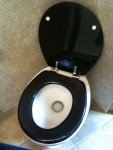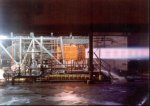Preparing for the Texas Mile
- Thread starter Mullet
- Start date
You are using an out of date browser. It may not display this or other websites correctly.
You should upgrade or use an alternative browser.
You should upgrade or use an alternative browser.
I was very scared that I was going to see a man in a thong running around in circles to "get" in shape!! :lol
Best of luck at the mile. Not like you need it though!! :wink :cheers
Best of luck at the mile. Not like you need it though!! :wink :cheers
So I am trying to figure out - is it the actual seat or using the seat that is getting credit for the weight savings?:wink
Where did you get it?
Where did you get it?
It's both 
wife got it for me online. Google carbon fiber toilet seat and a few places pop up that have them. Warning: you will have to get the hardware to attach as the bolt holes are non standard sizes. 5/8 th size nylon screws are needed
wife got it for me online. Google carbon fiber toilet seat and a few places pop up that have them. Warning: you will have to get the hardware to attach as the bolt holes are non standard sizes. 5/8 th size nylon screws are needed
watch it when those things explode there are sharp shards everywhere
I hope that is not from experience!
haha cool
I didnt make any changes either. Added 2-3psi and going to try to drive better since I'm not worried about one and done.
what psi you gonna be running?
I have my boost cut set at 26psi so Im hoping I peak around 25.5. Last fall, I peaked at 22.9 even though I was aiming for 24.what psi you gonna be running?
Kumar - what kind of driving suit do you have now?
Going to buy one this weekend. No idea. Had friends direct me to a racing store so whatever my fat ass will fit in.
- Aug 8, 2007
- 5,256
haha cool
I didnt make any changes either. Added 2-3psi and going to try to drive better since I'm not worried about one and done.
what psi you gonna be running?
that reminds me of an old saying:biggrin

somebody needs to find a NNNAAAWWWWSSSSS one for you Soroush. :lol
Go on, it can handle another 50hp jet......... :wink
Go on, it can handle another 50hp jet......... :wink
Where's the 6 point harness for your new carbon fiber purchase. I wouldn't want to see you fall off if your wifes driving TOO FAST to Goliad! Tomy Hamon
that reminds me of an old saying:biggrin

Soroush, nice pic of the turbocharger.
Understand in our FGT application the temperatures depicted in that picture would not occur for a very long duration, and in a mile run would only achieve Tmax at the end of a run. And a run at "Mullet speeds" only takes about 27 seconds. (I guesstimated approx 130 MPH average for the mile, 0 at start and 225 thru the traps).
At turbocharger Tmax and maximum rotational speed, the turbine stresses are quite high and the material Ultimate Tensile Strength (UTS) properties diminished due to temp (inversely proportional). Think about what might happen if the turbine disc bursts at that condition which I am relatively certain would be an "uncontained" event. Disc failures are always catastrophic in any application because they contain so much kinetic energy (which is usually not appreciated by the user). Just hope your turbo designer allowed for speed margin above his assumed design point when you push the envelope...
On a lighter note, turbine discs CAN be designed to operate at these elevated temperatures if the designer knows of these conditions during the design phase. Below is a picture of an engine which operates continuously (i.e. for HOURS) at the indicated metal translucent temperatures. And a disc failure in this engine would lead to loss of the aircraft.
Attachments
Now you really blow it out tail pipe. If you're not careful you're gona need a shoot to keep you from flying off the end.
Going to buy one this weekend. No idea. Had friends direct me to a racing store so whatever my fat ass will fit in.
Sparco is your friend :thumbsup
- Aug 8, 2007
- 5,256
Soroush, nice pic of the turbocharger.
Understand in our FGT application the temperatures depicted in that picture would not occur for a very long duration, and in a mile run would only achieve Tmax at the end of a run. And a run at "Mullet speeds" only takes about 27 seconds. (I guesstimated approx 130 MPH average for the mile, 0 at start and 225 thru the traps).
At turbocharger Tmax and maximum rotational speed, the turbine stresses are quite high and the material Ultimate Tensile Strength (UTS) properties diminished due to temp (inversely proportional). Think about what might happen if the turbine disc bursts at that condition which I am relatively certain would be an "uncontained" event. Disc failures are always catastrophic in any application because they contain so much kinetic energy (which is usually not appreciated by the user). Just hope your turbo designer allowed for speed margin above his assumed design point when you push the envelope...
On a lighter note, turbine discs CAN be designed to operate at these elevated temperatures if the designer knows of these conditions during the design phase. Below is a picture of an engine which operates continuously (i.e. for HOURS) at the indicated metal translucent temperatures. And a disc failure in this engine would lead to loss of the aircraft.
Indy, thank you for the tutorial on the Tmax, and the inversely proportional nature of Ultimate tensile strength and temp, However what you have failed to realize is that no matter what "mullet speed" will always be two miles slower than "soroush speed".:lol




